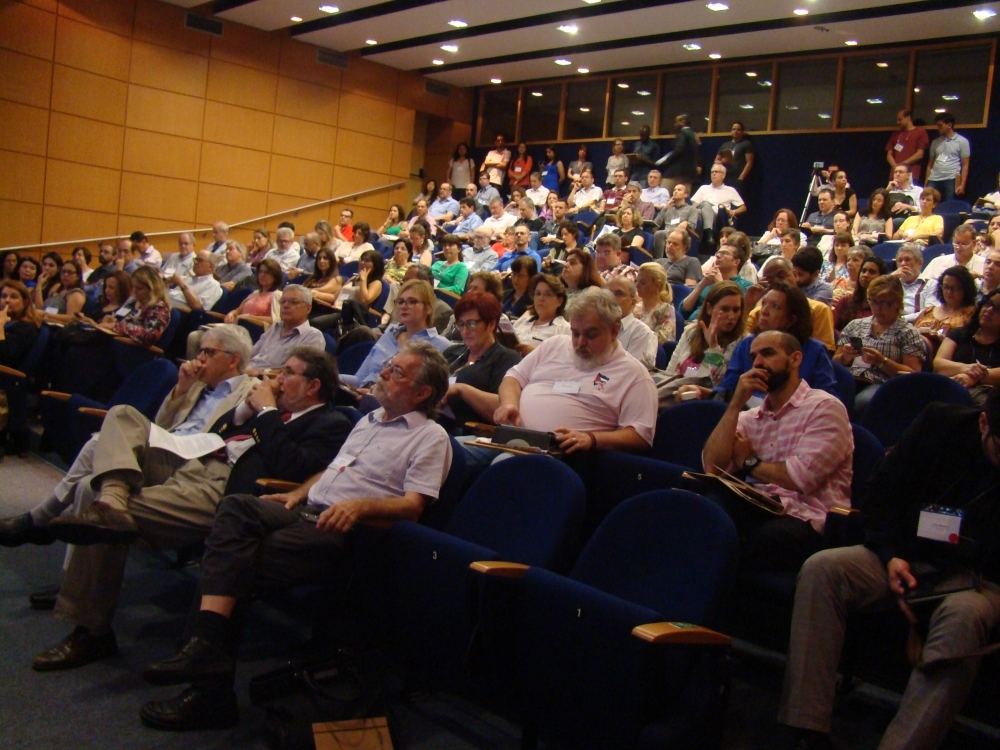

Executive Director of the US National Science Communication Institute says reforms must benefit both scientists and science (photo: Fernando Cunha / Agência FAPESP)
Executive Director of the US National Science Communication Institute says reforms must benefit both scientists and science.
Executive Director of the US National Science Communication Institute says reforms must benefit both scientists and science.

Executive Director of the US National Science Communication Institute says reforms must benefit both scientists and science (photo: Fernando Cunha / Agência FAPESP)
By Elton Alisson | Agência FAPESP – Scientific journals have undergone profound changes worldwide in recent years with the aim of speeding up the publication process, which many consider too slow, and to promote open access, which likewise has not advanced at a desirable speed, among other goals, according to Glenn Hampson, Executive Director of the National Science Communication Institute (nSCI) and Director of the Open Scholarship Initiative (OSI) Program in the United States.
Some of the changes under way involve “shaking up the current system” to utilize more modern publishing tools and approaches, requiring a generalized and coordinated effort by publishers, authors, and the scientific community, Hampson said during a remote presentation delivered by video to the Sixth Annual Meeting of the Scientific Electronic Library On Line (SciELO), held on December 14, 2016, at FAPESP’s auditorium in São Paulo, Brazil.
“There isn’t a lot of evidence that authors are 100% behind the reforms that are happening in journal publishing. There’s anxiety, angst and disagreement,” Hampson said.
“We need to make sure that what we’re doing is for the benefit of researchers and for the benefit of science.”
Journal publishing is part of a large and complex science communication ecosystem, Hampson went on. This ecosystem is poorly defined and is evolving through a variety of disconnected efforts and initiatives.
For some people, science communication means helping scientists become better communicators and learn to speak more clearly, especially to the media and policymakers.
To scholarly communications offices in universities, it might mean helping to manage an institutional repository or offering more open-access publications.
“Different stakeholders will have different approaches. That whole ecosystem is the reason the National Science Communication Institute was founded… to help define science communication as a more coherent field.”
While science communication – which consists of disseminating research findings to the scientific community and the public so as to foster the creation and diffusion of knowledge – is growing and changing, Hampson added, it is also trying to respond to the needs of a society that is creating much more information than at any other time in history and that is increasingly accustomed to getting information for free and immediately.
At the same time, society has “lost faith that science is immaculate and above reproach”. The public has less confidence that science provides reliable answers, according to Hampson.
Journals are part of the science communication process, so they too must change.
“Whether and how journal publishing transforms will depend largely on whether and how it can respond to these societal forces quickly and in a way that makes sense for authors and for science, in a way that the marketplace will find sustainable, in a way that funders and policymakers will support, and in a way that promotes the culture of communication in science,” Hampson said.
Journals will continue to play an important role in credentialing and filtering science. “Other forms of science publishing will continue to emerge and be tested,” Hampson concluded.
Challenges in Brazil
In Brazil, the challenges faced by journal publishing include the need to raise levels of professionalization, internationalization, and financial sustainability, according to other experts who took part in the event.
Brazil has about 430 internationally indexed scientific journals in total, and 285 of these are indexed by SciELO’s database, according to SciELO/FAPESP Program Director Abel Packer.
“Journals in the areas of health sciences, human sciences, applied social sciences and agricultural sciences account for 84% of SciELO’s Brazilian collection,” Packer said.
By 2017, all of SciELO’s journals will be indexed by the Directory of Open Access Journals (DOAJ), a community-curated online directory that indexes and provides access to high-quality, open-access, peer-reviewed journals from every part of the world.
“This new indexation complies with an international standard, which we’re using, and distinguishes between predatory and nonpredatory open-access journals,” Packer explained, referring to publications that do or do not charge processing fees once manuscripts are accepted.
Another 2017 target for SciELO is shortening the time to publication for articles in the journals included in its collection, especially in human and agricultural sciences.
“The proposal is for human and agricultural science journals to reduce the time taken to peer-review manuscripts and edit articles accepted for publication to an average of six months,” Packer said during the event.
With more than 500,000 open-access articles indexed and published online in 2016, SciELO manages a network of national journal collections covering 15 countries, mostly in Latin America and the Caribbean, as well as Portugal, South Africa, and Spain.
Over 1,200 titles have been indexed by the SciELO network since its creation. About 1,000 of these remain active, 285 of them in Brazil. The SciELO Program’s current development is funded by FAPESP.
“SciELO is an extremely important project with an extraordinary impact on enhancing the visibility and internationalization of Brazilian science,” said FAPESP CEO Carlos Américo Pacheco, during the event’s opening ceremony.
Republish
The Agency FAPESP licenses news via Creative Commons (CC-BY-NC-ND) so that they can be republished free of charge and in a simple way by other digital or printed vehicles. Agência FAPESP must be credited as the source of the content being republished and the name of the reporter (if any) must be attributed. Using the HMTL button below allows compliance with these rules, detailed in Digital Republishing Policy FAPESP.





